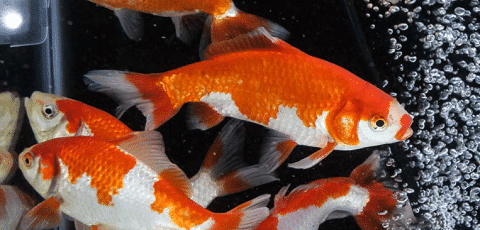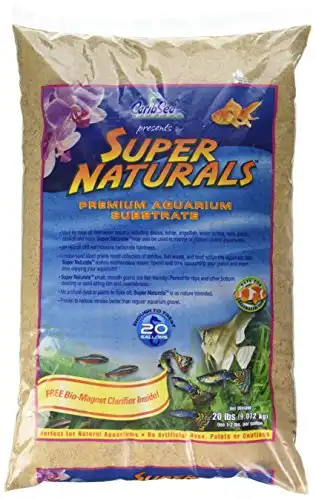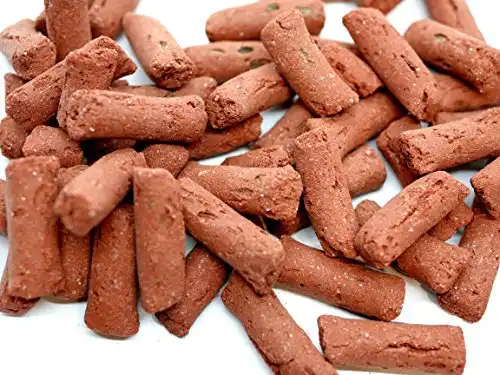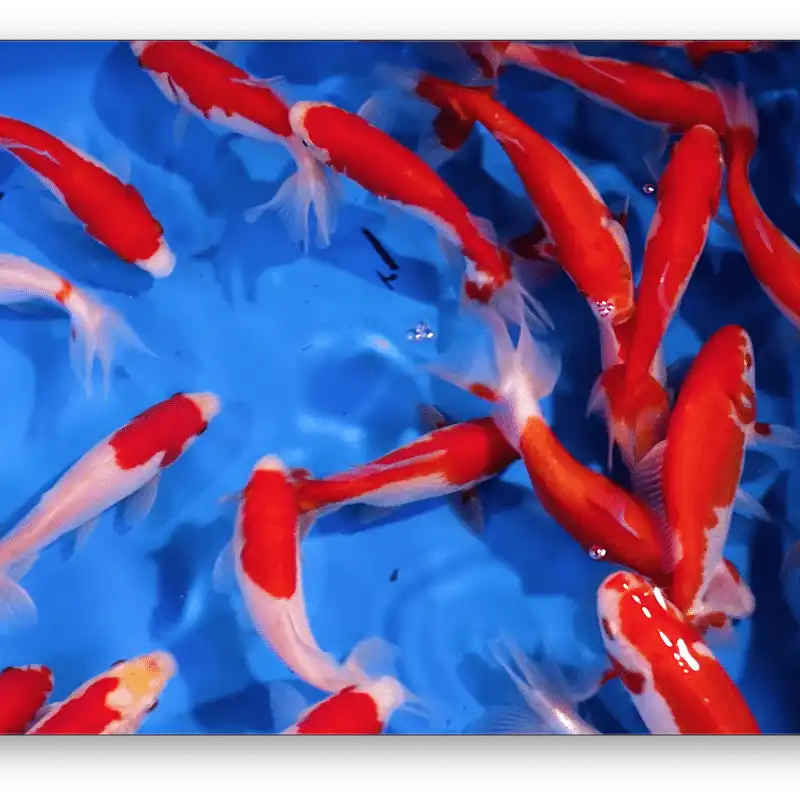Thank you for visiting! By the way… any links on this page that lead to products on Amazon and other stores/partners are affiliate links Aquarium Store Depot earns a commission if you make a purchase.
Just got yourself or considering a Wakin Goldfish? If so, this article about Wakin Goldfish Care will answer all your questions!
The vivid color, attractive double tail and friendly, curious temperament of the Wakin goldfish (carassius auratus) has led to an increase in its popularity in recent years. Originating in Japan like most other carp-descended fish, it was the original prototype, of sorts, of many other fancy goldfish breeds.
Wakin goldfish are a good choice for aquatic pet fish lovers since they’re not difficult to take care of. Although they are best brought up in a pond, they can also be housed in aquariums—with the right care guidelines, of course.
A Brief Overview of the Wakin Goldfish
| Scientific Name | Carassius Auratus Auratus |
| Common Names | Wakin, watonai |
| Family | Cyprinidae |
| Origin | Japan |
| Diet | Omnivore |
| Care Level | Moderate |
| Activity | Active |
| Lifespan | 10 to 15 Years |
| Temperament | Peaceful |
| Tank Level | Medium |
| Minimum Tank Size | 30 Gallons |
| Temperature Range | 65°F to 72°F |
| KH | 4-20 dGH |
| pH Range | 6.5 to 7.5 |
| Filtration/Water Flow | Moderate |
| Water Type | Freshwater |
| Breeding | Egg layers |
| Difficulty to Breed | Easy to breed |
| Compatibility | Community tank or species-only tank. Great with Koi in Ponds |
| OK, for Planted Tanks? | Mostly no |
Origins and Habitat
Like many other goldfish varieties, the wakin was first bred artificially in Japan in the early 16th century. In its early days, the wakin was a highly prized Japanese goldfish, and only available to the wealthy.
Generally, aquarists agree that most of the fancy goldfish breeds we know today originated from mutations in the wakin goldfish.
Like all other goldfish, the wakin is descended from the Chinese gibel carp1.
What Does Wakin Goldfish Look Like?

Similar to common goldfish (picture source), wakin goldfish are physically characterized by a slender and long body shape with no compression. They are classified as a lean bodied or slim-bodied goldfish. These types of goldfish are more atheltic and make for a more sturdy goldfish than other goldfish.
You will also know wakins by their split tail. However, unlike fancy double-tailed goldfish, these fish have long and flowing double tail. Their caudal fin, which is short, resembles more of a fantail shape.
Every wakin goldfish has a unique pattern on its body. In terms of coloration, they come in a wide variety, although they are mainly sought in white, red, or a combination of the two. Additionally, you might find rare colors like calico, yellow, orange and brown, but the rarer the color, the higher the price tag is likely to be.
And speaking of variations, you might also find the “watonai” variation of wakins, who have flowing tails.
- How Big are Wakin Goldfish?Add ImageAt a maximum length of 18 inches, wakin goldfish are some of the largest breeds of goldfish you’ll find. You’re more likely to see them grow to this size if you locate them in a pond instead of in a tank.
- How Long Do Wakin Goldfish Live?Add ImageThe average Wakin goldfish can live up to 10 to 15 years, with some exceptions. Those who are carefully looked after can thrive for as long as 20 years!
Temperament and Activity Level
Wakin goldfish are fast and lively fish who enjoy exploring their surroundings. They are mainly peaceful freshwater fish, able to coexist peacefully with most other community fish. That said, you should avoid putting them together with fancy goldfish, since the latter are slow swimmers. As such, they’ll have to compete for access to food.
Wakin goldfish are also well-loved for their friendly and curious nature. In fact, once you start feeding them regularly, you’ll start to notice how they rush to the surface of the pond or tank to greet you when feeding time is due.
What are Good Tank Mates?
Great Tank Mates
As fast swimmers, these pet fish are best kept with other fast species such as:
- Koi Fish
- Shubunkin Goldfish
- Comet Goldfish
Besides goldfish, apple snails, ghost shrimps, African dwarf frogs, rosy barbs, and weather loaches.
Fish Species to Avoid
Generally, the Wakin goldfish are friendly and playful with most other community fish. However, there are certain fish that don’t get along with them. For instance, you should avoid housing them with aquarium fish species like fancy goldfish as they are slow swimmers and therefore, at a disadvantage during feeding time. You also shouldn’t choose aggressive tank mates for the these fish, such as cichlids.
Just got yourself or considering a Wakin Goldfish? If so, this article about Wakin Goldfish Care will answer all your questions!
The vivid color, attractive double tail and friendly, curious temperament of the Wakin goldfish (carassius auratus) has led to an increase in its popularity in recent years. Originating in Japan like most other wild carp descended fish, it was the original prototype, of sorts, of many other fancy goldfish breeds.
Wakin goldfish are a good choice for aquatic pet lovers since they’re not difficult to take care of. Although they are best brought up in a pond, they can also be housed in aquariums—with the right care guidelines, of course.
How Big Are They?
At a maximum length of 18 inches, wakin goldfish are some of the largest breeds of goldfish you’ll find. You’re more likely to see them grow to this size if you locate them in a pond instead of in a tank.
How Long Do They Live?
The average Wakin goldfish can live up to 10 to 15 years, with some exceptions. Those who are carefully looked after can thrive for as long as 20 years!
Temperament and Activity Level
Wakin goldfish are lean bodied goldfish that are fast and lively fish. They enjoy exploring their surroundings. They are mainly peaceful freshwater fish, able to coexist peacefully with most other community fish. That said, you should avoid putting them together with fancy goldfish, since the latter are slow swimmers. As such, they’ll have to compete for access to food.
Wakin goldfish are also well-loved for their friendly and curious nature. In fact, once you start feeding them regularly, you’ll start to notice how they rush to the surface of the pond or tank to greet you when feeding time is due.
What Do They Eat?
The Waking Goldfish breed is omnivorous. This means that giving them high quality fish food and a varied diet they need is easy, and you can usually feed them most low-fat foods.
You can give them flakes or pellets, but as always, these should not be their only nutrition source. Instead, you should aim to mix it up by introducing vegetables such as lettuce, broccoli, cabbage and shelled peas, and occasionally, chunks of fruits like strawberries and grapes. Also, if you keep them in an aquarium with live plants, don’t be surprised if they start grazing on them.
Of course, you should always be cautious about overfeeding them, because doing so can lead to the development of one or more of the digestive conditions or swim bladder problems.
What About Live Foods?
Brine shrimp, Tubifex worms, blackworms, bloodworms, mosquito larvae, etc. make good live foods for these fish. Freeze dried and frozen sources of protein will also work.
How Much and How Often to Feed
A proper diet is very important for the well-being of your goldfish. Feed them too little and they will fall sick, feed them too much and they will have buoyancy problems.
The Wakin fish are omnivores which means they can feast on plant and animal matter. While basic store-bought pellets and flakes are a good source of nutrition, try to bring new variations of food. For example, try to drop some lettuce or diced grapes once a week or so and watch how your fish react to it.
When you’re buying fish food, try to get a mixture of both plant and animal-based varieties. Also, you should choose pellets that sink to the floor rather thank floating on the surface. Goldfish like searching for food at the base of the tank and with variation in the pellets, they won’t get bored.
You should feed them no more than twice daily and no more than what they can finish off within 3-4 minutes. Remove any leftovers from the water to ensure that the water remains inhabitable.
Tank Requirements (Care)
Here’s what to keep in mind when setting up your wakin tank.
Tank Size
Wakin fish can grow quite large and therefore need a lot of room to live freely. A large body also means more waste released into the aquarium.
With this in mind, at least a 30 gallon tank is required to house one of these guys, along with an additional 10 gallons of water for each new fish. But there are no limits: the larger the aquarium size, the better. To maximize their happiness and lifespan, outdoor ponds are the best place for a Wakin. You can see a great example of a wakin goldfish tank below by C Lifestyle.
Tank Setup
There are some basic elements your tank must have in order for your Wakins to live and thrive.
Temperature
Wakins prefer to live and thrive in cold water; they should be placed in unheated tanks. The ideal water temperature range for them is 65 to 72 degrees F.
pH
Maintain a neutral pH for them between 6.0 and 8.0.
Ammonia and Nitrate
Ammonia and nitrate levels should be kept at 0.
Substrate
Large, smooth gravel is a good substrate or a fine sandy substrate is best for Wakin goldfish. This is because goldfish love scouring around, they might mistake gravel for food. The wrong gravel size can be accidentally shallowed by your goldfish. Caribsea sand is great for goldfish.
This sand by Caribsea is perfect for supporting the foraging habit of goldfish. Also works with bottom feeders and discus fish.
Decor
Using plastic plants along with certain moss types will enhance the look of your aquarium. You can add large stones and small sticks as well to replicate a pond and give your fish plenty of options to play.
Plants
Keeping natural vegetation is difficult when it comes to wakin, who love to eat plants. More active ones might even uproot plants. Moreover, many plants won’t survive in the colder temperatures that wakins like. Knowing this, here are several plants that can take the punishment of these fish or may be ignored entirely:
If you do not want to deal with the hassle artificial plants is advised. In large commercial size ponds, plants are often omitted
Filtration
To deal with the typically large amounts of goldfish waste, go with a filtration system meant for large tanks. It’s also advised to get a filtration system with a larger tank capacity than what your setup has. A large power filter is minimum for a Wakin in a aquarium. For ponds, consider a waterfall style filtration system. Large ponds over 1500 gallons will often consider bead filtration for maximum biological filtration.
Since these fish are large and produce a lot of waste, consider a high end biological media like biohome.
Editor's Choice!
This is the best media you can buy for your aquarium. It does it all - removes ammonia, nitrite, and nitrates
How to Breed
We have certain pointers for those of you who are particularly interested in creating your own Wakin ecosystem.
To push your mating, you must first replicate the natural changes they go through in a pond. Firstly, since they mate during spring, dropping the water temperature to 60 or 65 degrees F will signal the fish to procreate.
You must offer the fish adequate natural vegetation such as the Java moss in order to create suitable egg laying zones. You can also look for artificial spawning mops which do the same job as the moss. You should see fry within 48-72 hours of eggs being laid.
Note that in larger ponds, Wakin Goldfish breed regularly. If you don’t want an overflowing pond, you’ll have to make regular checks. Larger fish like Koi will eat baby fry.
Health and Disease
The best way to keep your fish healthy is with great filtration and a quality diet. Prevention is the best remedy when it comes to health. If you are wondering if your fish is unhealthy, there are some pointers to help.
Signs of Good Health
A healthy wakin is one that retains its friendly, lively and curious nature. You will see it frequently dipping in and out of tank and pond decorations, swimming swiftly and actively, and eating large amounts of food in short amounts of time.
Signs of Poor Health and Treatment
Unfortunately, like all goldfish varieties, wakins are also susceptible to freshwater fish diseases like ich, fin rot, bacterial infections, fluke, etc. The article I linked to contains a wealth of information on how to identify and cure many common diseases you may come across. Common signs of an ill fish would be:
- Rapid breathing
- Flashing or scratching rocks/gravel
- White and stringy poop
- Red marks and ulcers
- Torn or clamped fins
- White spots (not to be confused with mating white spots of goldfish who are breeding)
Wakins are less susceptible to bloat and other diseases that plague fancy goldfish.
Where to Buy (And Cost)
You can find them for sale online and at many aquarium stores. The main issue you will run into when shopping locally is the quality of Wakins. They are usually classified as beginner fish and usually not kept in good conditions. The best place to purchase in my mind is from a garden retailer who specializes in pond fish. Wakin goldfish cost more for at these retailers, but they are of superior quality.
My favorite of these are NextDayKoi. They offer a variety of quality goldfish that work well in ponds and larger aquariums. You won’t be disappointed ordering from them!
With their elongated bodies and unique fins, Wakins are a flash of color and character to your pond
Frequently Asked Questions
How big do these goldfish get?
In a pond, they might grow to be 18 inches long.
Are they aggressive?
They are not aggressive, although they are fast and active fish who should not be kept with slow-moving fish like fancy goldfish
What do they eat?
As omnivores, they thrive on a varied diet. Besides flakes and pellets, you should also aim to give them vegetables, fruits, and occasionally live foods.
Are they rare?
They aren’t very rare, but not very easy to find either. Especially if you have a small budget, or want special colors on them such as calico and brown, you might have a harder time finding them for sale. The fanciest varieties will often be imported.
Is it better to keep them in a fish pond or an aquarium?
Due to their affinity for cold, slow-moving water, they do best in ponds with lots of natural sources of food and of course, space to swim about in. They are also more likely to reach their maximum length of 18 inches if kept in a pond, and breed more easily.
However, you can also keep them in a tank as long as you closely follow the guidelines we’ve detailed above.
Closing Thoughts
With adequate amounts of living space, a varied diet and dedicated care, the Wakin goldfish could be the new pride and joy of your home aquarium. Although it’s best to put them in ponds, replicating a pond environment is also possible. I hope you found these tips helpful! Please leave your comments below so I can continue providing helpful information about these wonderful fish and others in our hobby.
- About the Author
- Latest Posts
I’m thrilled that you found Aquarium Store Depot! Here you’ll find information on fish, aquariums, and all things aquatics related. I’m a hobbyist (being doing this since I was 11) and here to help other hobbyists thrive with their aquariums! I adhere to a high quality Editorial Process and Review products with real life field usage and practical analysis.








